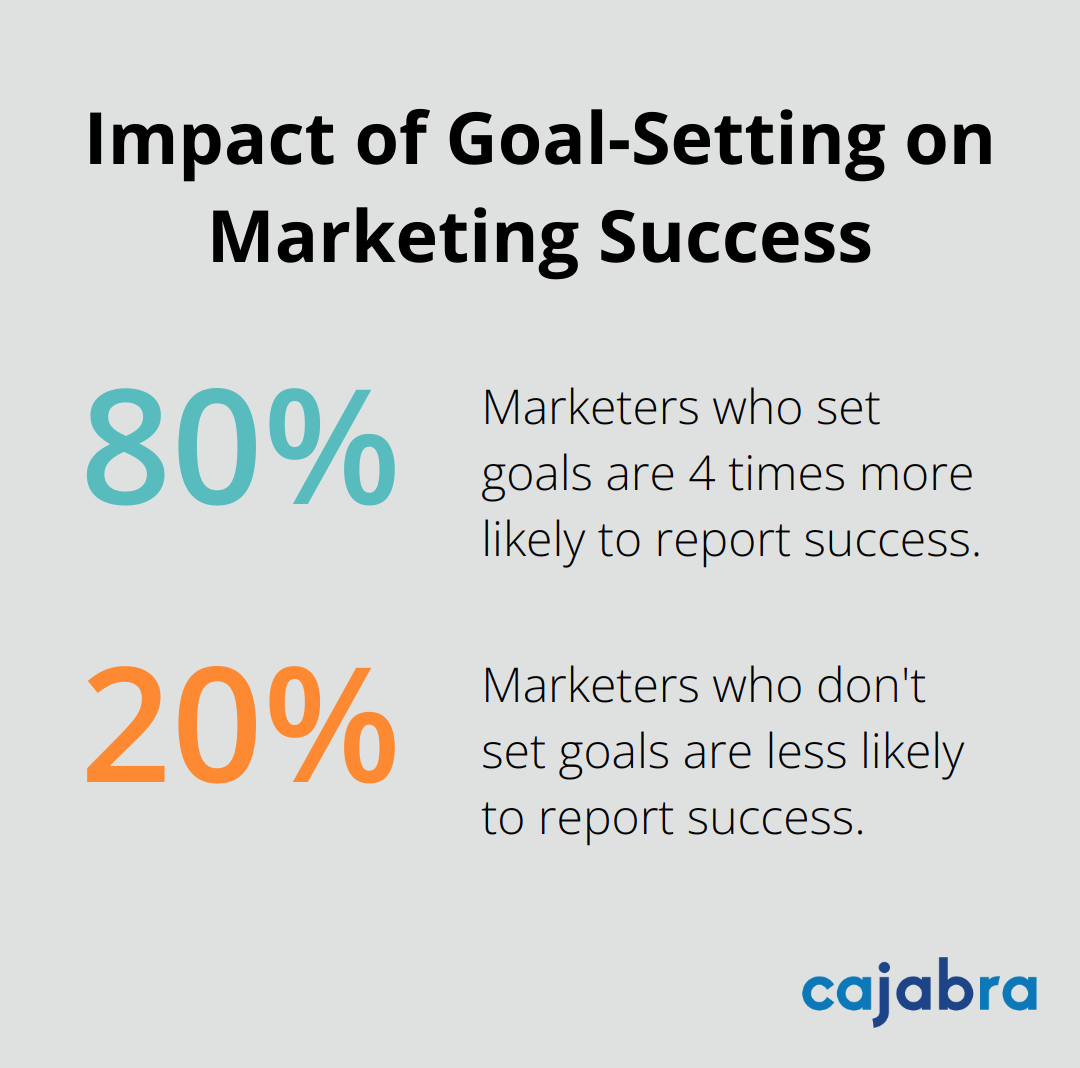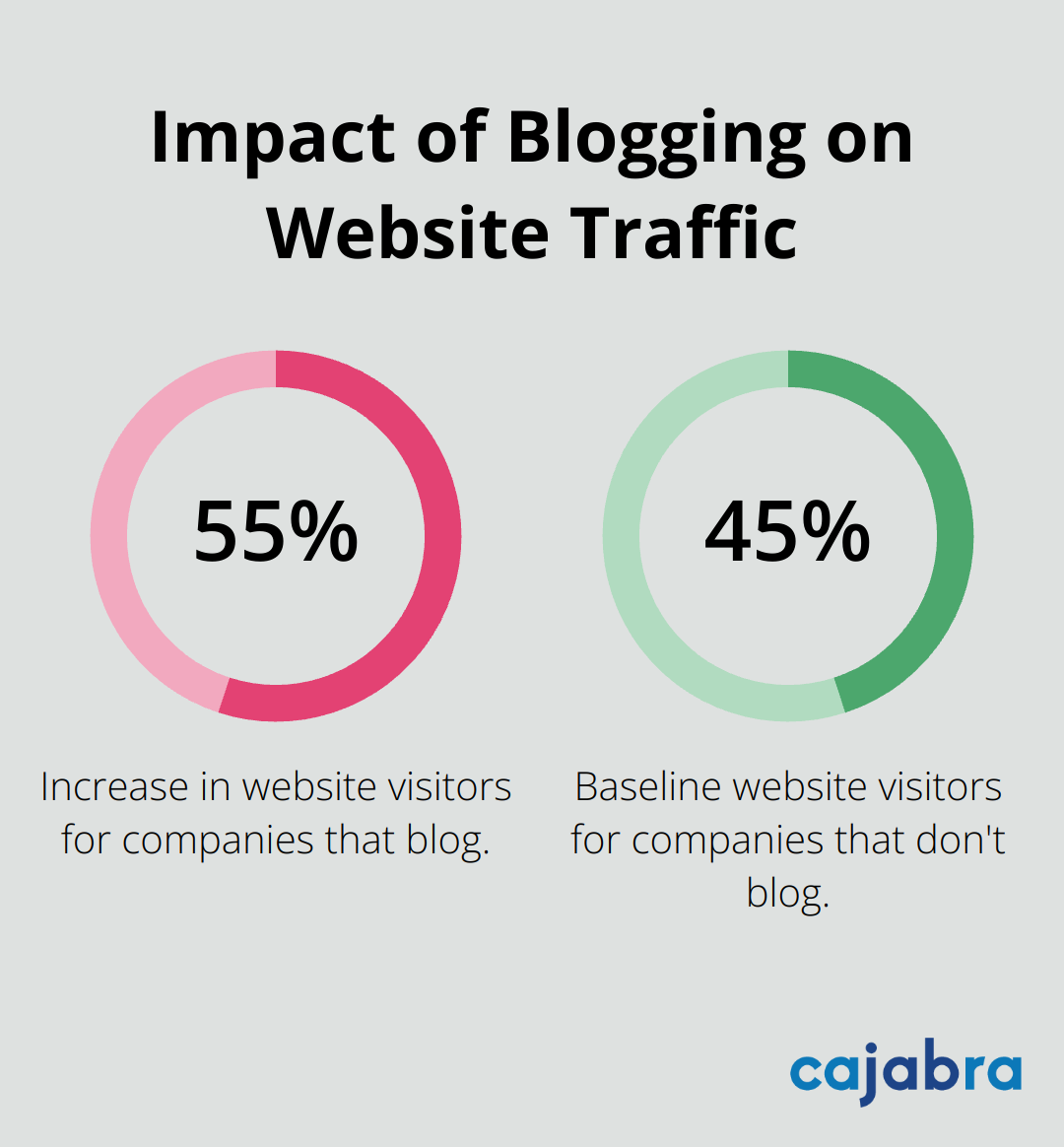
Content marketing is a powerful tool for businesses to attract and engage their target audience. At Cajabra, LLC, we've seen firsthand how a well-crafted content marketing plan can drive results.
In this post, we'll guide you through the essential steps to create an effective content marketing plan that aligns with your business goals and resonates with your audience.
Clear, well-defined goals form the foundation of every successful content marketing plan. Without them, your content efforts may lack focus and effectiveness. At Cajabra, LLC, we recommend using SMART goals (Specific, Measurable, Achievable, Relevant, and Time-bound) to guide your strategy.
For example, instead of a broad goal like "increase website traffic," try to set a more specific objective: "Increase organic traffic by 25% within the next six months through weekly blog posts and bi-monthly video content." This approach provides a clear target and timeline for your efforts.
A study by CoSchedule highlights the importance of goal-setting: marketers who set goals are nearly 4 times more likely to report success than those who do not. This statistic underscores the value of establishing clear objectives for your content strategy.

Your content won't connect if you don't know your audience. Create detailed buyer personas based on real data, not assumptions. Use tools such as Google Analytics, social media insights, and customer surveys to collect information about your audience's demographics, behaviors, and pain points.
This data-driven approach allows you to tailor your content to address specific needs and preferences, increasing its relevance and impact.
Your content marketing goals should directly support your overall business objectives. If your company aims to increase market share in a specific industry, your content strategy might focus on establishing thought leadership in that sector.
HubSpot's State of Marketing Report reveals that 70% of marketers actively invest in content marketing. To stand out in this crowded field, your strategy must align tightly with your unique business goals.
Establish key performance indicators (KPIs) to track your progress towards your content marketing goals. These might include metrics such as:
Regular analysis of these metrics (ideally on a monthly or quarterly basis) will help you identify what's working and what needs adjustment in your content strategy.
The digital landscape evolves rapidly, and your content marketing goals should reflect these changes. Stay informed about industry trends, emerging platforms, and shifts in consumer behavior. This knowledge will help you adapt your goals and strategies to remain relevant and effective.
As you move forward with your content marketing plan, the next crucial step involves developing a robust content strategy and editorial calendar. This process will help you translate your goals into actionable content creation and distribution plans.
Start by choosing content types that resonate with your audience. The Content Marketing Institute reports that 46% of marketers think their content marketing budget will increase in 2025 compared to 2024. Popular formats include blog posts, videos, infographics, and podcasts. Each format serves different purposes and appeals to various audience segments.

Long-form blog posts excel at in-depth explanations and SEO. Videos quickly engage viewers and explain complex concepts visually. Infographics distill complex data into digestible visuals (perfect for social media sharing). Podcasts offer a convenient way for busy professionals to consume content on-the-go.
Develop a content theme for each month or quarter. This approach maintains consistency and allows for in-depth topic exploration. Use tools like Google Trends, BuzzSumo, or SEMrush to identify popular industry topics. Also, leverage insights from your sales and customer service teams to address common questions and pain points your audience faces.
For example, a finance industry content calendar might look like this:
This thematic approach simplifies individual content piece brainstorming and ensures a cohesive content strategy.
Consistency drives success in content marketing. Companies that blog get 55% more website visitors than businesses that don't. However, quality should never take a backseat to quantity.
Create a realistic publishing schedule based on your resources. If you're just starting, try to produce 1-2 high-quality pieces per week. As you grow, you can increase frequency. Use project management tools like Trello or Asana to track content from ideation to publication.
Factor in lead time for content creation, editing, and approval processes. Also, consider timing your content releases to coincide with industry events, holidays, or other relevant occasions to maximize impact.
Clear role assignment ensures smooth content production and distribution. Identify team members responsible for:
Clearly define each role's responsibilities and establish communication channels for seamless collaboration.
A robust review process maintains content quality and brand consistency. Establish a workflow that includes:
This process (when followed consistently) helps prevent errors, ensures alignment with brand guidelines, and maintains high content standards.
With your content strategy and calendar in place, the next step involves implementing effective content creation and distribution processes. These processes will bring your carefully planned strategy to life and ensure your content reaches and engages your target audience.
Establish a clear workflow for content production. Create detailed briefs for each piece of content. These briefs should outline the topic, target audience, key points to cover, and desired outcomes. This approach ensures all team members align on the content's purpose and direction.
Set up a content calendar using tools like Trello or Asana. Assign tasks to team members and set realistic deadlines. An effective content workflow is essential for a successful marketing strategy.
SEO plays a vital role in content visibility. Conduct keyword research using tools like SEMrush or Ahrefs to identify relevant, high-volume search terms. Incorporate these keywords naturally into your content, including headers, meta descriptions, and image alt text.
Focus on creating comprehensive, high-quality content that answers user queries. Google's algorithm favors in-depth, authoritative content. Search engine optimization (SEO) optimizes web content and site architecture to improve visibility in organic search engine results.
Don't rely on a single channel to distribute your content. Use a mix of owned, earned, and paid media to maximize reach. Share your content on social media platforms where your audience is most active.
Email marketing remains a powerful distribution channel. Segment your email list and personalize content to increase engagement.

Maximize the value of your content by repurposing it across different formats. Transform a blog post into an infographic, podcast episode, or video. This approach not only saves time but also caters to different content consumption preferences.
You could transform a detailed guide into a series of social media posts, an email course, or a webinar. This strategy allows you to reach a wider audience and reinforce your message across multiple touchpoints.
Analyze your content performance regularly using tools like Google Analytics. Track key metrics such as page views, time on page, bounce rate, and conversions. Use these insights to refine your content strategy and focus on what resonates most with your audience.
A/B testing can be particularly effective. Test different headlines, content formats, or distribution times to optimize your content's performance.
A content marketing plan requires careful planning, execution, and ongoing refinement. You must define clear goals, understand your audience, and align your strategy with business objectives. The implementation of your plan through streamlined content creation, SEO optimization, and diverse distribution channels will maximize the impact of your content.
Regular measurement and analysis of performance data allow you to improve and adapt your strategy to changing market conditions. Consistency proves key in content marketing, so stick to your publishing schedule and maintain high-quality standards across all content pieces. You should assess your content's performance regularly and adjust your approach based on data-driven insights.
At Cajabra, we've witnessed how a well-executed content marketing plan can transform an accounting firm's online presence and client acquisition. Our marketing services for accountants leverage content marketing to help firms stand out in a competitive landscape. A robust content strategy will position your business as an industry leader, attract ideal clients, and drive sustainable growth.



